Macroscopic Spray Behavior of a Single-Hole Common Rail Diesel Injector Using Gasoline-Blended 5% Biodiesel
Abstract
1. Introduction
2. Materials and Methods
2.1. Test Fuels
2.2. Experimental Setup
2.3. Experimental Procedure
2.3.1. Fuel Injection Conditions
2.3.2. Post-Processing Images
3. Results
3.1. Spray Characteristics
3.2. GB05 Spray Structure
3.3. The Flow Fields of GB05 Spray
4. Conclusions
- Increased injection pressure causes increased spray length because the increased momentum flux does not depend directly on the test fuel (fuel properties). Therefore, the effect of injection pressure on the spray penetration length of GB05 and neat diesel fuel are similar. At higher injection pressure, the spray can travel farther in the chamber.
- Like neat diesel, the spray cone angle of GB05 is enlarged with increased ambient pressure. However, the cone angle of GB05 increases less than that of neat diesel because cavitation phenomena occur in the GB05 flow, which inhibits the effect of the ambient pressure.
- The average speed and the instantaneous speed of GB05 and neat diesel are similar. At SOI 0.3–0.7 ms, the free spray speed immediately increases and is then continuously boosted. After that, it decreases rapidly until the end of the injection timing.
- The injection pressure and back pressure have the greatest effects on the spray structure and distribution. At high ambient pressure, the shape and size of the free spray are affected. The free spray clearly contracts and the liquid jet still remains after the needle closes.
- The spray density of GB05 is continuously distributed along the free spray at both the low and high back pressures. Moreover, wavy motions are found at the medium and high injection pressures, which causes a buckled shape.
- Although the spray flow field of GB05 appears to be similar to the diesel spray at the entrainment and recirculation zone, the air entrainment has an effect on the GB05 at the spray tip region but there is no clear evidence of an effect on the diesel (from past research). This suggests that using gasoline injected with a common rail injection system could improve the air-fuel mixing process.
- At high injection pressure and low back pressure, vortexes and vorticity are formed throughout the spray area, in large numbers and magnitude. This indicates a high-turbulence spray structure and heterogeneous fuel-air mixing distribution. In addition, the spray tip penetration of GB05 is lower than that of the diesel spray due to its low viscosity, density and surface tension (from the literature). Therefore, when using gasoline in a high-pressure injection system, the injection pressure can be increased with less spray impingement on the piston, and the fuel-air mixing process is better than when using diesel, facilitating the auto-ignition of gasoline.
Author Contributions
Funding
Conflicts of Interest
Nomenclature
| PLIF | Planar laser-induced fluorescence |
| PIV | Particle-image velocimetry |
| LTC | Low-temperature combustion |
| CI | Compression ignition |
| HCCI | Homogeneous charge compression ignition |
| PPCI | Partially premix compression ignition |
| GCI | Gasoline compression ignition |
| CVCC | Constant volume combustion chamber |
| PCV | Pressure control valve |
| DPSS | Diode-pumped solid-state |
| IP | Injection pressure |
| GB | Gasoline-Biodiesel |
| GDI | Gasoline direct injection |
| SOI | Start of injection |
| ASOI | After start of injection |
| DI | Direct injection |
References
- Sasaki, S.; Ito, T.; Iguchi, S. Smoke-Less rich combustion by low temperature oxidation in diesel engines. In Proceedings of the 9th Aachen Colloquium Automobile and Engine Technology, Beijing, China, 13–15 November 2019; p. 767. [Google Scholar]
- Akihama, K.; Takatori, Y.; Inagaki, K.; Sasaki, S.; Dean, A.M. Mechanism of the Smokeless Rich Diesel Combustion by Reducing Temperature; SAE Techical Paper; SAE International: Warrendale, PA, USA, 2001; pp. 648–662. [Google Scholar] [CrossRef]
- Onishi, S.; Jo, S.H.; Shoda, K.; Jo, P.D.; Kato, S. Active Thermo-Atmosphere Combustion (ATAC)—A New Combustion Process for Internal Combustion Engines; SAE Techical Paper; SAE International: Warrendale, PA, USA, 1979; pp. 1851–1860. [Google Scholar] [CrossRef]
- Tongroon, M.; Zhao, H. Combustion Characteristics of CAI Combustion with Alcohol Fuels; SAE Techical Paper; SAE International: Warrendale, PA, USA, 2010. [Google Scholar] [CrossRef]
- Sang, W.; Cheng, W.K.; Maria, A. The Nature of Heat Release in Gasoline PPCI Engines; SAE Techical Paper; SAE International: Warrendale, PA, USA, 2014. [Google Scholar] [CrossRef]
- Hepp, C.; Krenn, M.; Wasserbauer, J.; Eichlseder, H. Dual Fuel Compression Ignition Combustion Concept for Gasoline and Diesel; SAE Techical Paper; SAE International: Warrendale, PA, USA, 2014. [Google Scholar] [CrossRef]
- Sun, J.; Bittle, J.A.; Jacobs, T.J. Influencing Parameters of Brake Fuel Conversion Efficiency with Diesel/Gasoline Operation in a Medium-Duty Diesel Engine; SAE Techical Paper; SAE International: Warrendale, PA, USA, 2013. [Google Scholar] [CrossRef]
- Cracknell, R.; Ariztegui Cortijo, J.; Dubois, T.; Engelen, B.; Manuelli, P.; Pellegrini, L.; Rickeard, D.J.; Heuser, B.; Schnorbus, T.; Kolbeck, A.F. Exploring a Gasoline Compression Ignition (GCI) Engine Concept; SAE Techical Paper; SAE International: Warrendale, PA, USA, 2014. [Google Scholar] [CrossRef]
- Singh, A.P.; Sharma, N.; Agarwal, R.; Agarwal, A.K. Advanced Combustion Techniques and Engine Technologies for the Automotive Sector, Energy, Environment, and Sustainability; Springer Nature Singapore Pte Ltd.: Singapore, 2020. [Google Scholar] [CrossRef]
- Thongchai, S.; Lim, O.. Investigation of the combustion characteristics of gasoline compression ignition engine fueled with gasoline-biodiesel blends. J. Mech. Sci. Technol. 2018, 32, 959–967. [Google Scholar] [CrossRef]
- Ra, Y.; Loeper, P.; Andrie, M.; Krieger, R.; Foster, D.E.; Reitz, R.D.; Durrett, R. Gasoline DICI Engine Operation in the LTC Regime Using Triple-Pulse Injection. SAE Int. J. Eng. 2012. [Google Scholar] [CrossRef]
- Sellnau, M.C.; Sinnamon, J.; Hoyer, K.; Kim, J.; Cavotta, M.; Husted, H. Part-Load Operation of Gasoline Direct-Injection Compression Ignition (GDCI) Engine; SAE Techical Paper; SAE International: Warrendale, PA, USA, 2013. [Google Scholar] [CrossRef]
- Wadumesthrige, K.; Ara, M.; Salley, S.O.; Ng, K.Y.S. Investigation of Lubricity Characteristics of Biodiesel in Petroleum and Synthetic Fuel. Energy Fuels 2009, 23, 2229–2234. [Google Scholar] [CrossRef]
- Suresh, M.; Jawahar, C.P.; Richard, A. A review on biodiesel production, combustion, performance, and emission characteristics of non-edible oils in variable compression ratio diesel engine using biodiesel and its blends. Renew. Sustain. Energy Rev. 2018, 92, 38–49. [Google Scholar] [CrossRef]
- Xiao, H.; Yang, X.; Hou, B.; Wang, R.; Xue, Q.; Ju, H. Combustion performance and pollutant emissions analysis of a diesel engine fueled with biodiesel and its blend with 2-methylfuran. Fuel 2019, 237, 1050–1056. [Google Scholar] [CrossRef]
- Zhong, W.; Li, B.; He, Z.; Xuan, T.; Lu, P.; Wang, Q. Experimental study on spray and combustion of gasoline/hydrogenated catalytic biodiesel blends in a constant volume combustion chamber aimed for GCI engines. Fuel 2019, 253, 129–138. [Google Scholar] [CrossRef]
- Pinazzi, P.M.; Hwang, J.; Kim, D.; Foucher, F.; Bae, C. Influence of injector spray angle and gasoline- diesel blending ratio on the low load operation in a gasoline compression ignition (GCI) engine. Fuel 2018, 222, 496–505. [Google Scholar] [CrossRef]
- Kim, K.; Bae, C.; Johansson, B. Spray and Combustion Visualization of Gasoline and Diesel under Different Ambient Conditions in a Constant Volume Chamber; SAE Techical Paper; SAE International: Warrendale, PA, USA, 2013. [Google Scholar] [CrossRef]
- Payri, R.; Garcia, A.; Domenech, V.; Durrett, R.; Plazas Torres, A. Hydraulic Behavior and Spray Characteristics of a Common Rail Diesel Injection System Using Gasoline Fuel; SAE Techical Paper; SAE International: Warrendale, PA, USA, 2012. [Google Scholar] [CrossRef]
- Desantes, J.M.; Payri, R.; Salvador, F.J.; Manin, J. Influence on Diesel Injection Characteristics and Behavior Using Biodiesel Fuels; SAE Techical Paper; SAE International: Warrendale, PA, USA, 2009. [Google Scholar] [CrossRef]
- Das, S.K.; Kim, K.; Lim, O. Experimental study on non-vaporizing spray characteristics of biodiesel blended gasoline fuel in a constant volume chamber. Fuel Process. Technol. 2018, 178, 322–335. [Google Scholar] [CrossRef]
- Allocca, L.; Mancaruso, E.; Montanaro, A.; Vaglieco, B.M.; Vassallo, A. Renewable Biodiesel/Reference Diesel Fuel Mixtures Distribution in Non-Evaporating and Evaporating Conditions for Diesel Engines; SAE Techical Paper; SAE International: Warrendale, PA, USA, 2009. [Google Scholar] [CrossRef]
- Postrioti, L.; Grimaldi, C.N.; Ceccobello, M.; Gioia, R.D. Diesel Common Rail Injection System Behavior with Different Fuels; SAE Techical Paper; SAE International: Warrendale, PA, USA, 2004. [Google Scholar] [CrossRef]
- Settles, G.S. Schlieren and Shadowgraph Techniques, 1st ed.; Springer Science & Business Media: Berlin/Heidelberg, Germany, 2001. [Google Scholar]
- Manaka, Y.; Ohta, T.; Saito, M.; Furuhata, T.; Arai, M. Effect of High Ambient Pressure on Behavior and Structure of Diesel Spray. In Proceedings of the 11th International Annual Conference on Liquid Atomization and Spray Systems 2009, Vail, CO, USA, 26–30 July 2009; pp. 1–6. [Google Scholar]
- Gonzalez, R.C.; Woods, R.E.; Eddins, S.L. Digital Image Processing Using MATAB, 2nd ed.; Gatesmark Publishing: Knoxville, TN, USA, 2009. [Google Scholar]
- Mathworks. Image Processing Toolbox TM User’s Guide R2014b; The MathWorks, Inc.: Natick, MA, USA, 2014. [Google Scholar]
- Knothe, G. The Lubricity of Biodiesel; SAE Techical Paper; SAE International: Warrendale, PA, USA, 2005. [Google Scholar] [CrossRef]
- Hu, J.; Du, Z.; Li, C.; Min, E. Study on the lubrication properties of biodiesel as fuel lubricity enhancers. Fuel 2005, 84, 1601–1606. [Google Scholar] [CrossRef]
- Atadashi, I.M.; Aroua, M.K.; Aziz, A.A. High quality biodiesel and its diesel engine application: A review. Renew. Sustain. Energy Rev. 2010, 14, 1999–2008. [Google Scholar] [CrossRef]
- Bao, Y.; Chan, Q.N.; Kook, S.; Hawkes, E. Spray Penetrations of Ethanol Gasoline and Iso-Octane in an Optically Accessible Spark-Ignition Direct-Injection Engine. SAE Int. J. Fuels Lubr. 2014. [Google Scholar] [CrossRef]
- Khonsari, M.M.; Booser, E.R. Applied Tribology: Bearing Design and Lubrication, 2nd ed.; John Wiley & Sons: Hoboken, NJ, USA, 2008. [Google Scholar] [CrossRef]
- Park, S.H.; Youn, I.M.; Lim, Y.; Lee, C.S. Influence of the mixture of gasoline and diesel fuels on droplet atomization, combustion, and exhaust emission characteristics in a compression ignition engine. Fuel Process. Technol. 2013, 106, 392–401. [Google Scholar] [CrossRef]
- Ejim, C.E.; Fleck, B.A.; Amirfazli, A. Analytical study for atomization of biodiesels and their blends in a typical injector: Surface tension and viscosity effects. Fuel 2007, 86, 1534–1544. [Google Scholar] [CrossRef]
- Thielicke, W.; Stamhuis, E.J. PIVlab—Towards User-friendly, Affordable and Accurate Digital Particle Image Velocimetry in MATLAB. J. Open Res. Softw. 2014, 2. [Google Scholar] [CrossRef]
- Du, C.; Andersson, M.; Andersson, S. The Influence of Ethanol Blending in Diesel fuel on the Spray and Spray Combustion Characteristics. SAE Int. J. Fuels Lubr. 2014. [Google Scholar] [CrossRef]
- Huang, H.; Dabiri, D.; Gharib, M. On errors of digital particle image velocimetry. Meas. Sci. Technol. 1997, 8, 1427–1440. [Google Scholar] [CrossRef]
- Lee, K.H.; Lee, C.H.; Lee, C.S. An experimental study on the spray behavior and fuel distribution of GDI injectors using the entropy analysis and PIV method. Fuel 2004, 83, 971–980. [Google Scholar] [CrossRef]
- Payri, R.; Gimeno, J.; Viera, J.P.; Plazas, A.H. Schlieren visualization of transient vapor penetration and spreading angle of a prototype diesel direct-acting piezoelectric injector. In Proceedings of the 12th International Annual Conference on Liquid Atomization and Spray Systems 2012, Heidelberg, Germany, 2–6 September 2012; pp. 1–8. [Google Scholar]
- Payri, F.; Bermúdez, V.; Payri, R.; Salvador, F.J. The influence of cavitation on the internal flow and the spray characteristics in diesel injection nozzles. Fuel 2004, 83, 419–431. [Google Scholar] [CrossRef]
- Jeon, J.; Moon, S. Ambient density effects on initial flow breakup and droplet size distribution of hollow-cone sprays from outwardly-opening GDI injector. Fuel 2018, 211, 572–581. [Google Scholar] [CrossRef]
- Yokogawa, K.; Kobashi, Y.; Kato, S. Analysis of Turbulence in Diesel Spray Using Time-Resolved PIV. In Proceedings of the 13th International Annual Conference on Liquid Atomization and Spray Systems 2015, Tainan, Taiwan, 23–27 August 2015; pp. 1–7. [Google Scholar]
- Zhu, J.; Kut, O.A.; Nishida, K. An Investigation of the Effects of Fuel Injection Pressure, Ambient Gas Density and Nozzle Hole Diameter on Surrounding Gas Flow of a Single Diesel Spray by laer-induced fluorescence-particle image velocimetry Technique. Int. J. Engine Res. 2013. [Google Scholar] [CrossRef]
- Azetsu, A.; Dodo, S.; Someya, T.; Oikawa, C. A Study on the Structure of Diesel Spray (2-D Visualization of the Non-Evaporating Spray). In Proceedings of the International Symposium on Diagnostics and Modeling of Combustion in Internal Combustion Engines 1990, Kyoto, Japan, 3–5 September 1990; pp. 199–204. [Google Scholar]
- Zhu, J.Y.; Nishida, K.; Kuti, O.A. PIV Study on Flow Fields of Spray and Surrounding Gas under Non-Evaporating and Evaporating Conditions. In Proceedings of the 12th International Annual Conference on Liquid Atomization and Spray Systems 2012, Heidelberg, Germany, 2–6 September 2012; pp. 1–8. [Google Scholar]
- Lee, J.; Yamakawa, M.; Isshiki, S.; Nishida, K. An Analysis of Droplets and Ambient Air Interaction in a D.I. Gasoline Spray Using LIF-PIV Technique Reprinted From: SI Combustion and Flow Diagnostics; SAE Techical Paper; SAE International: Warrendale, PA, USA, 2016. [Google Scholar] [CrossRef]
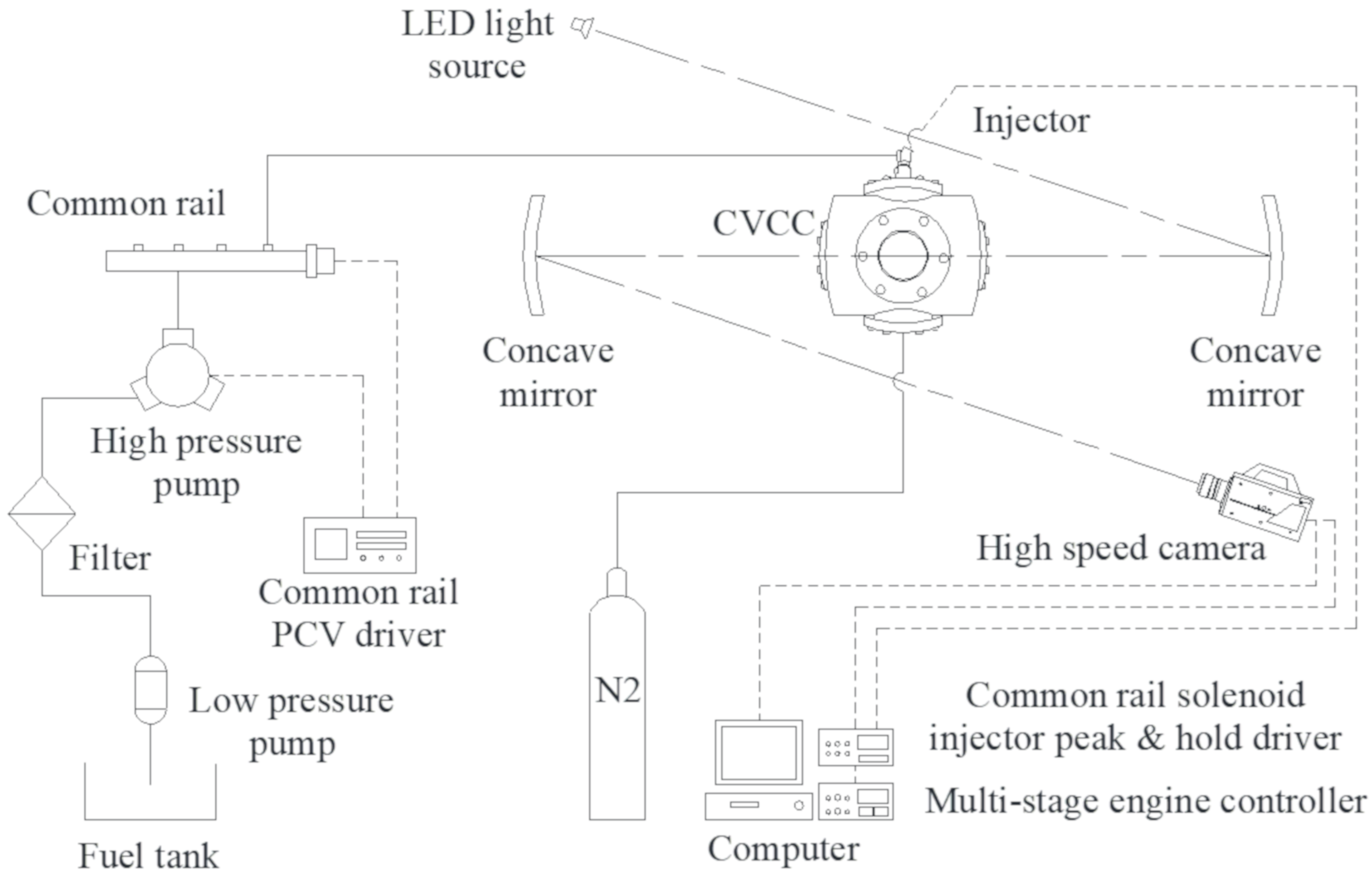

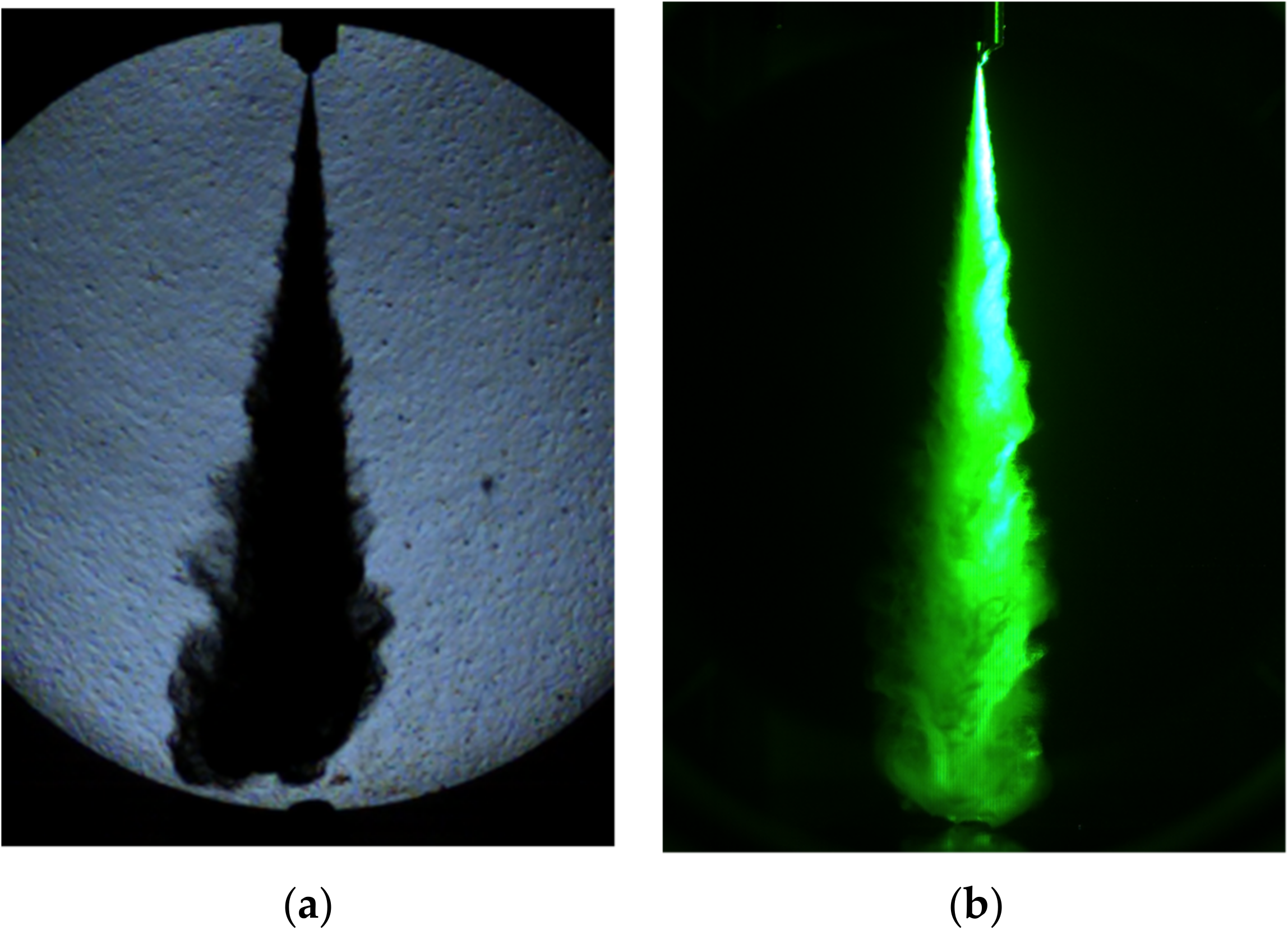

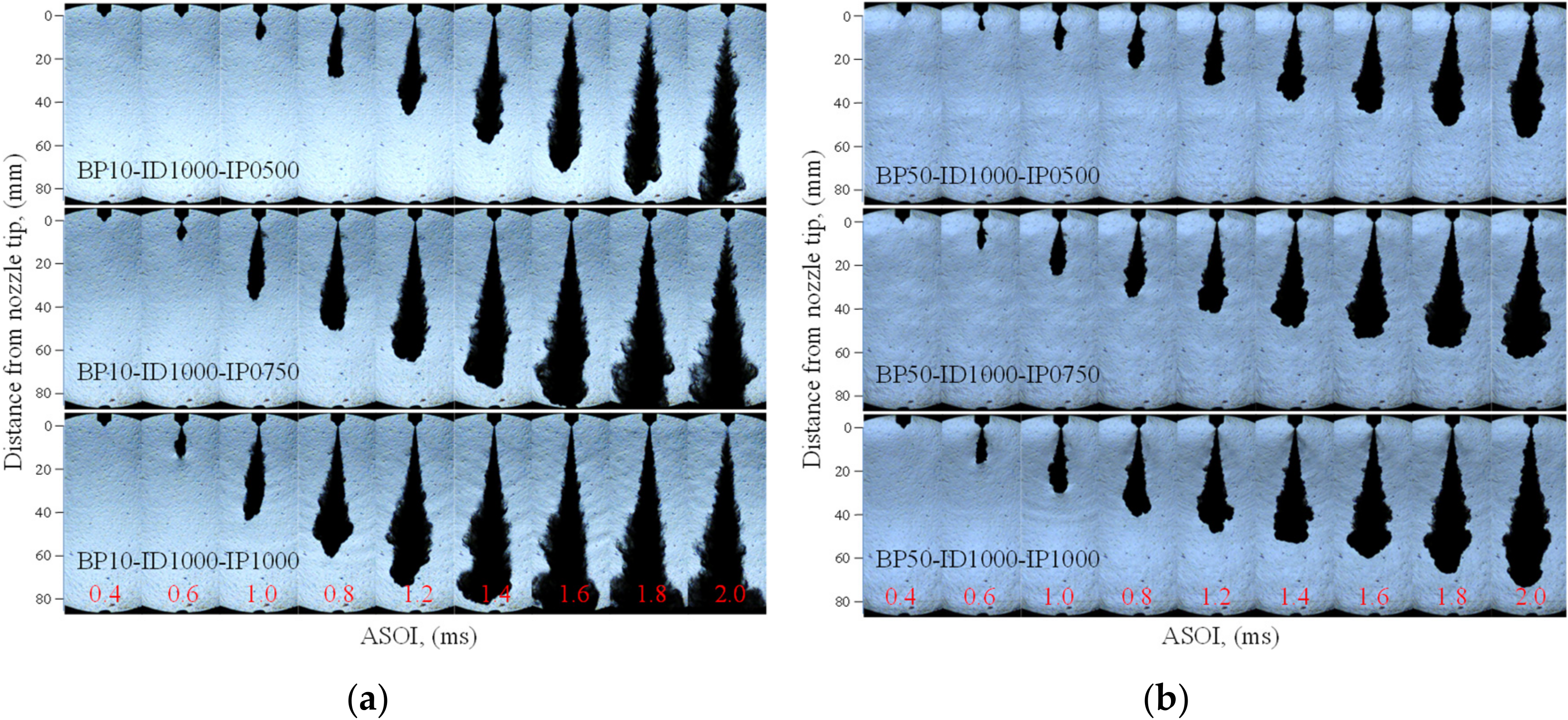
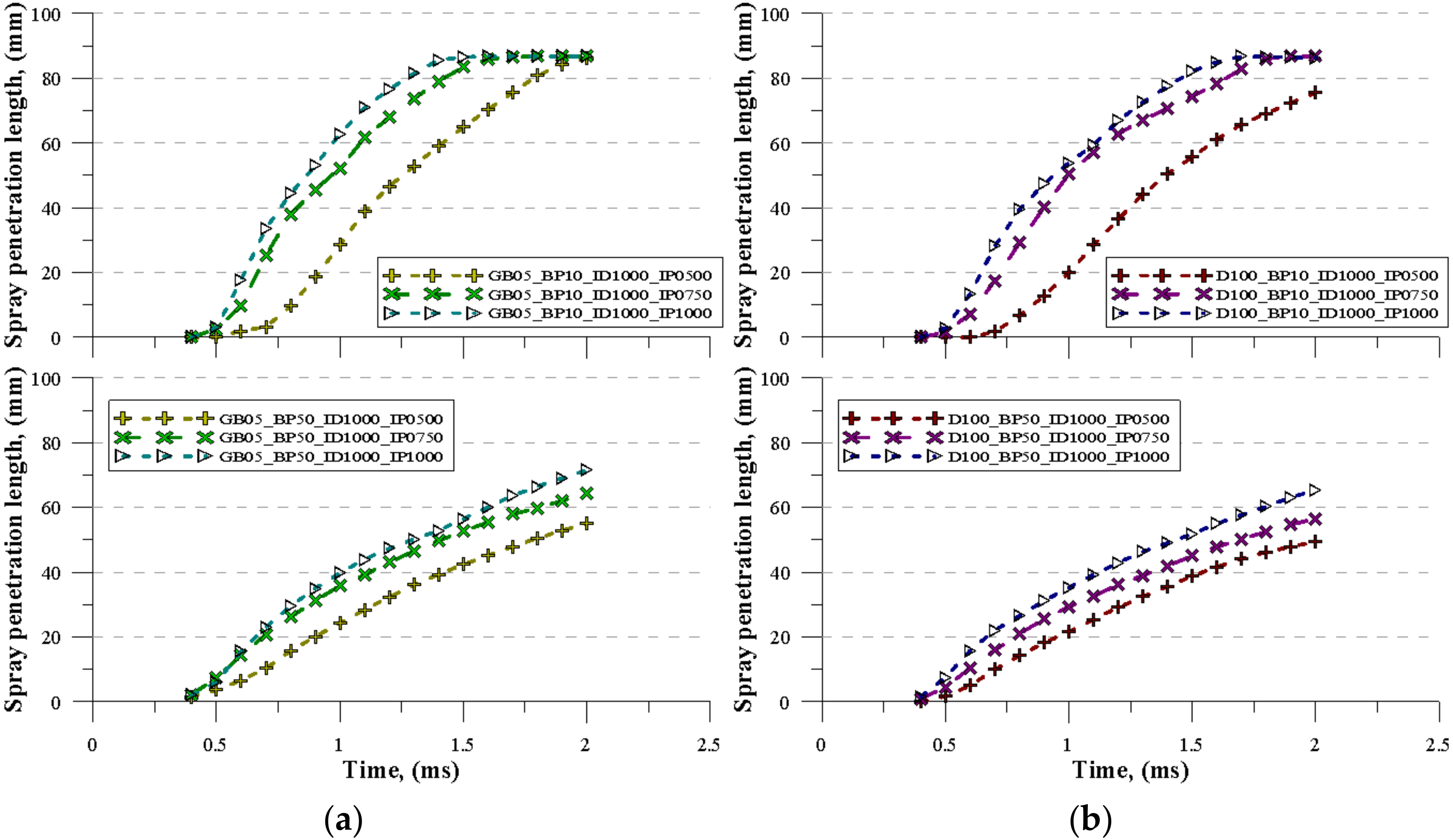
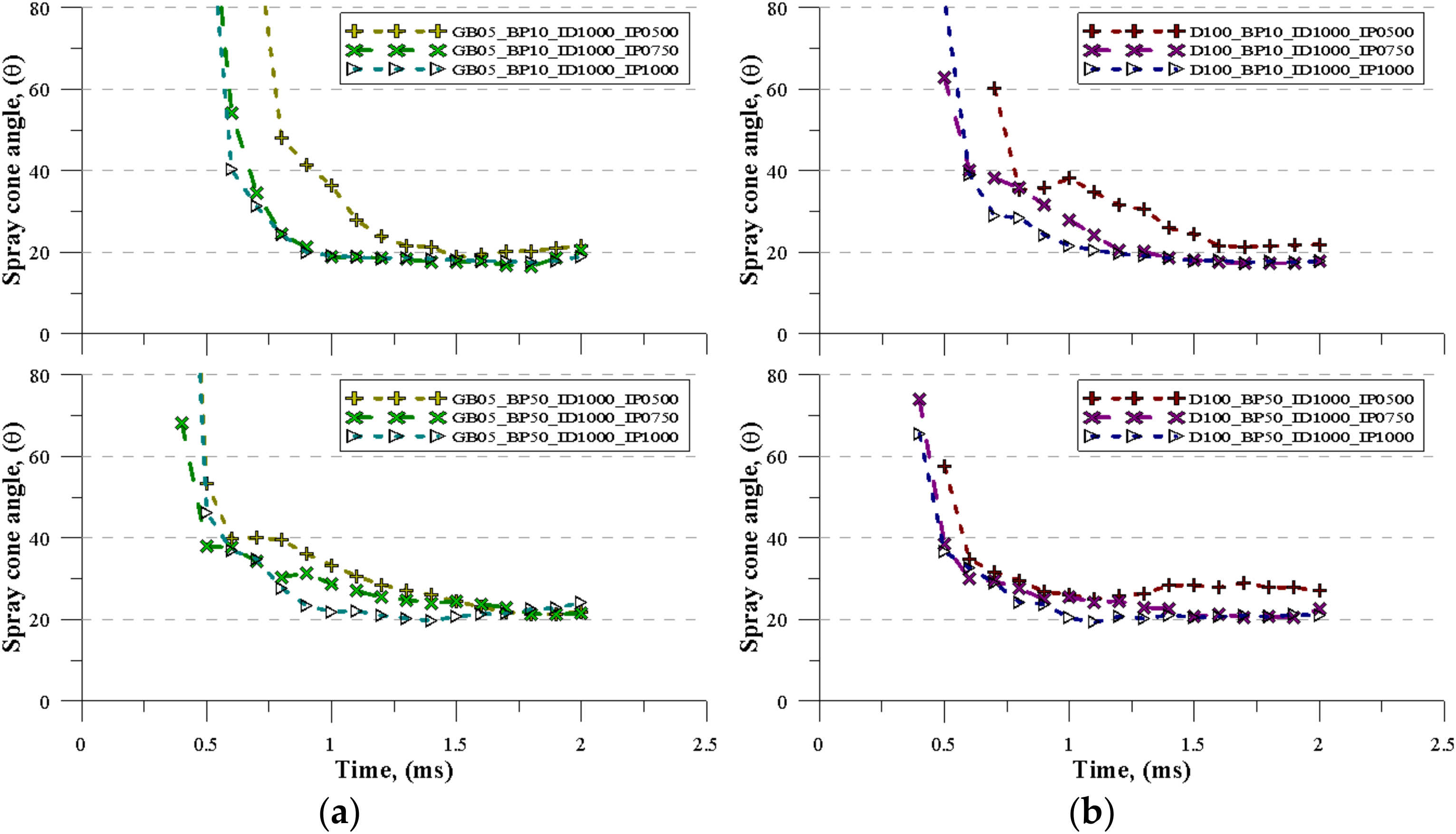


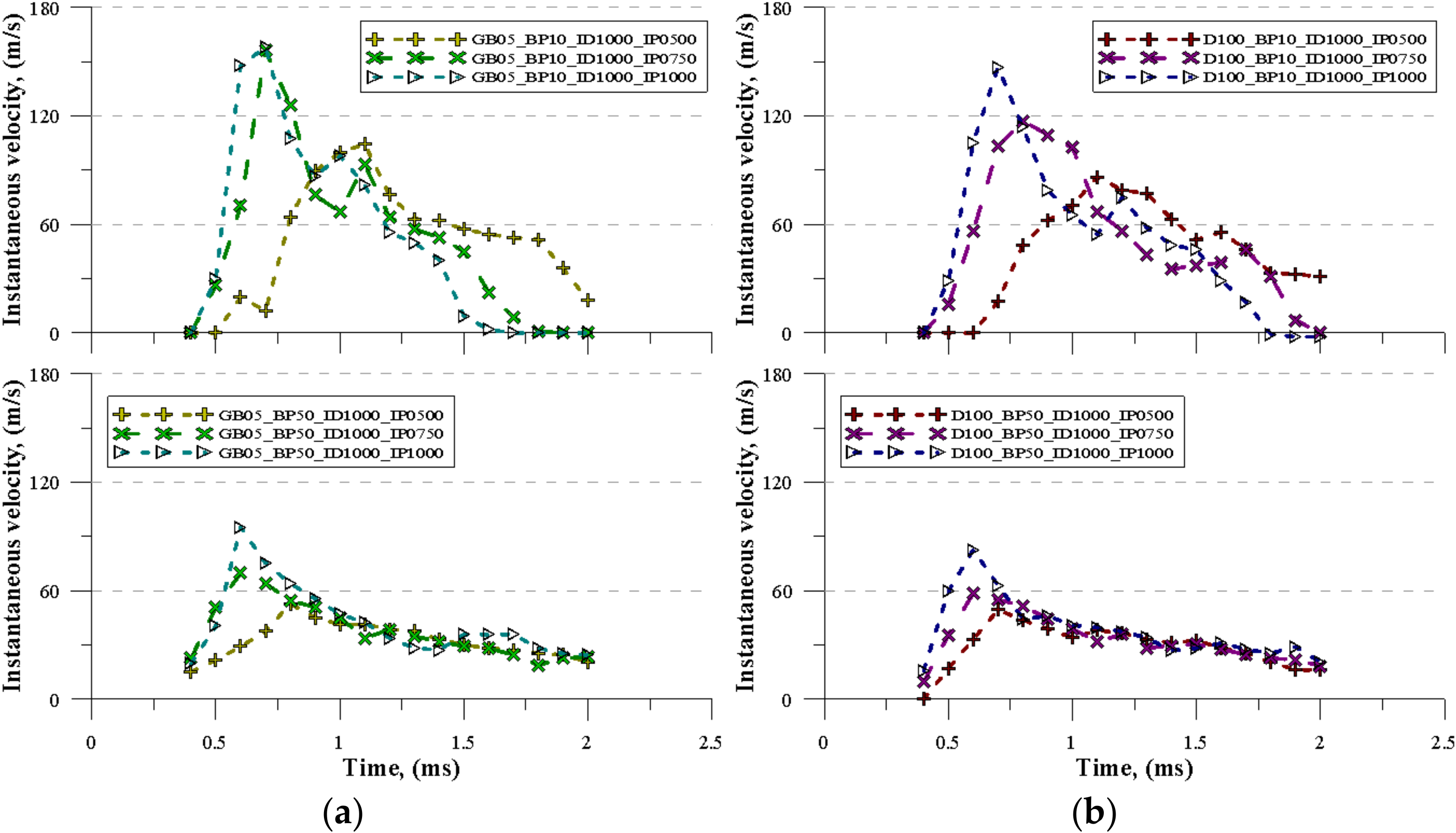
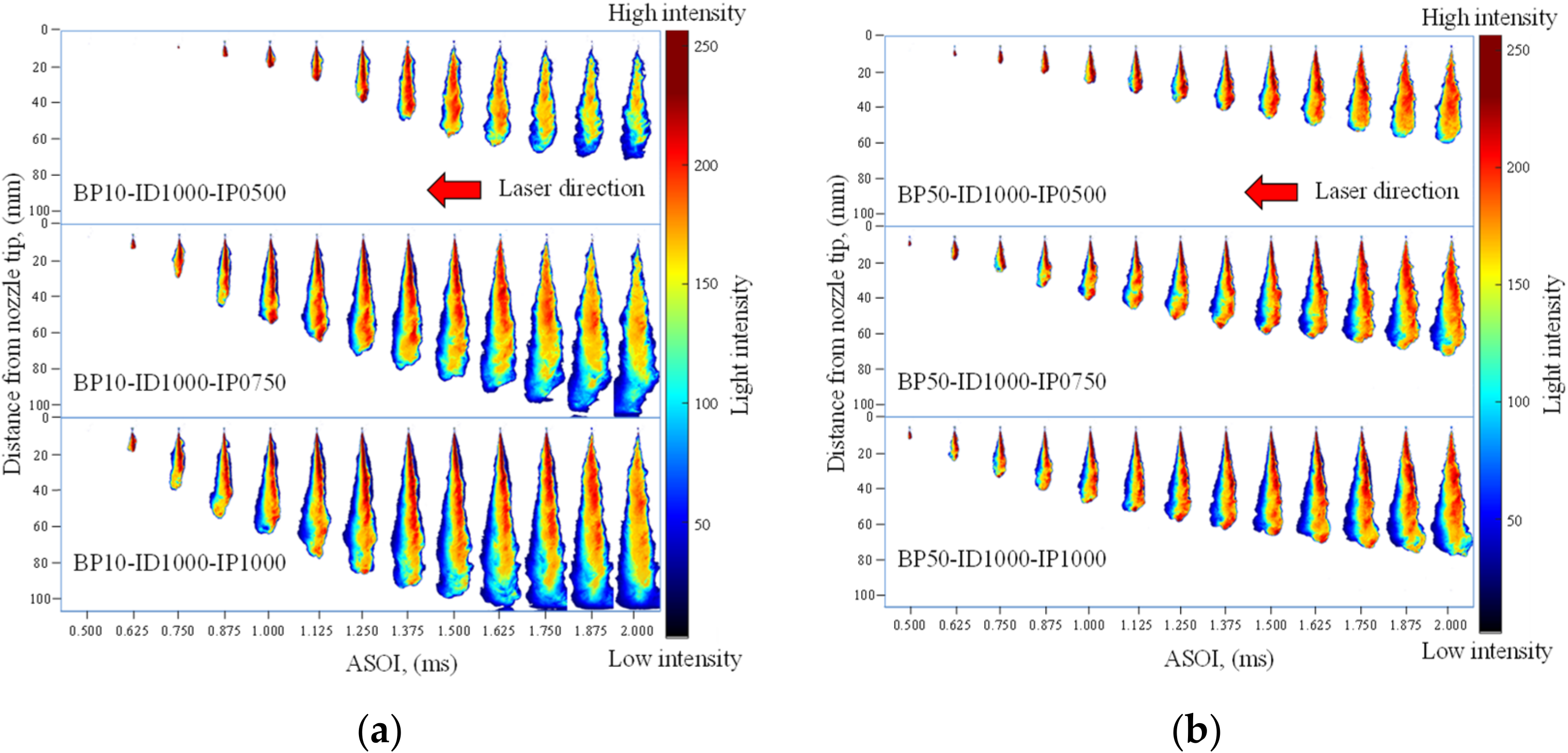
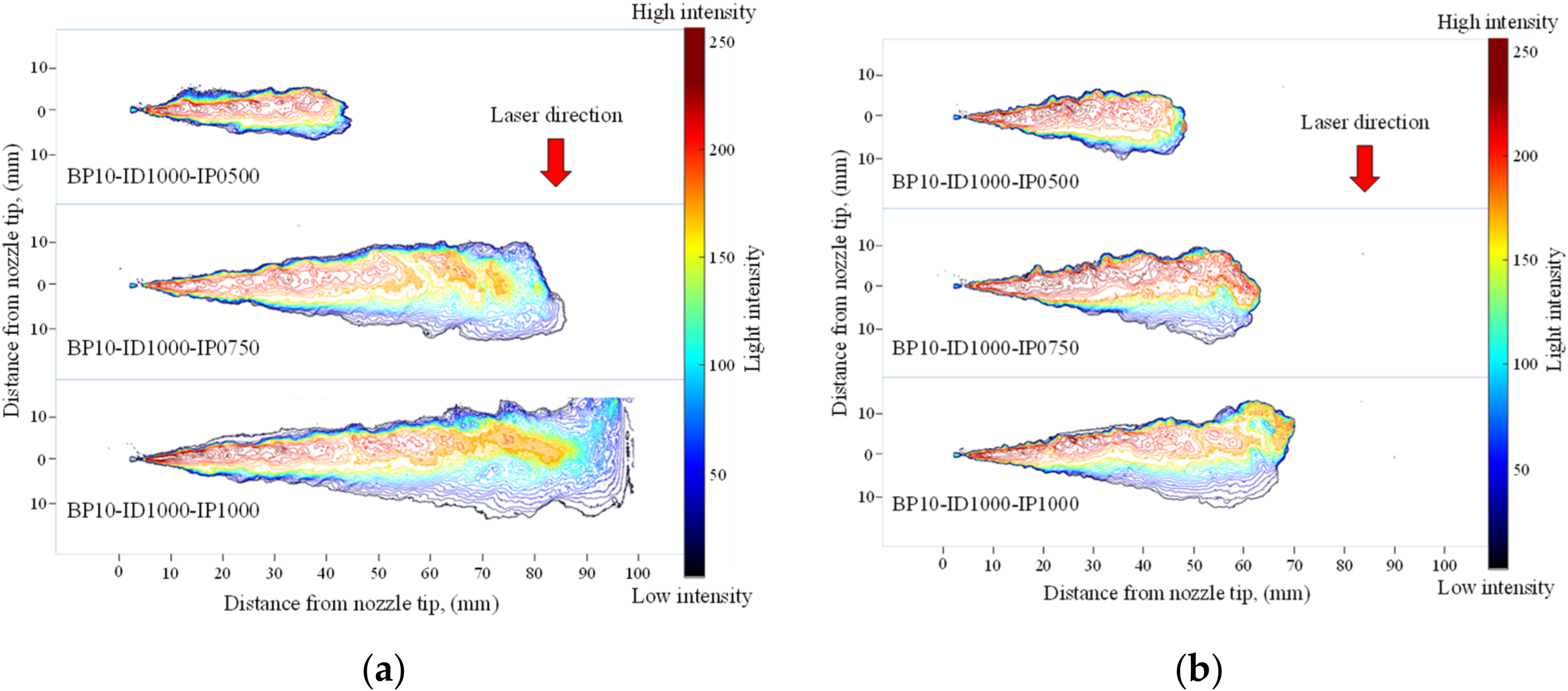
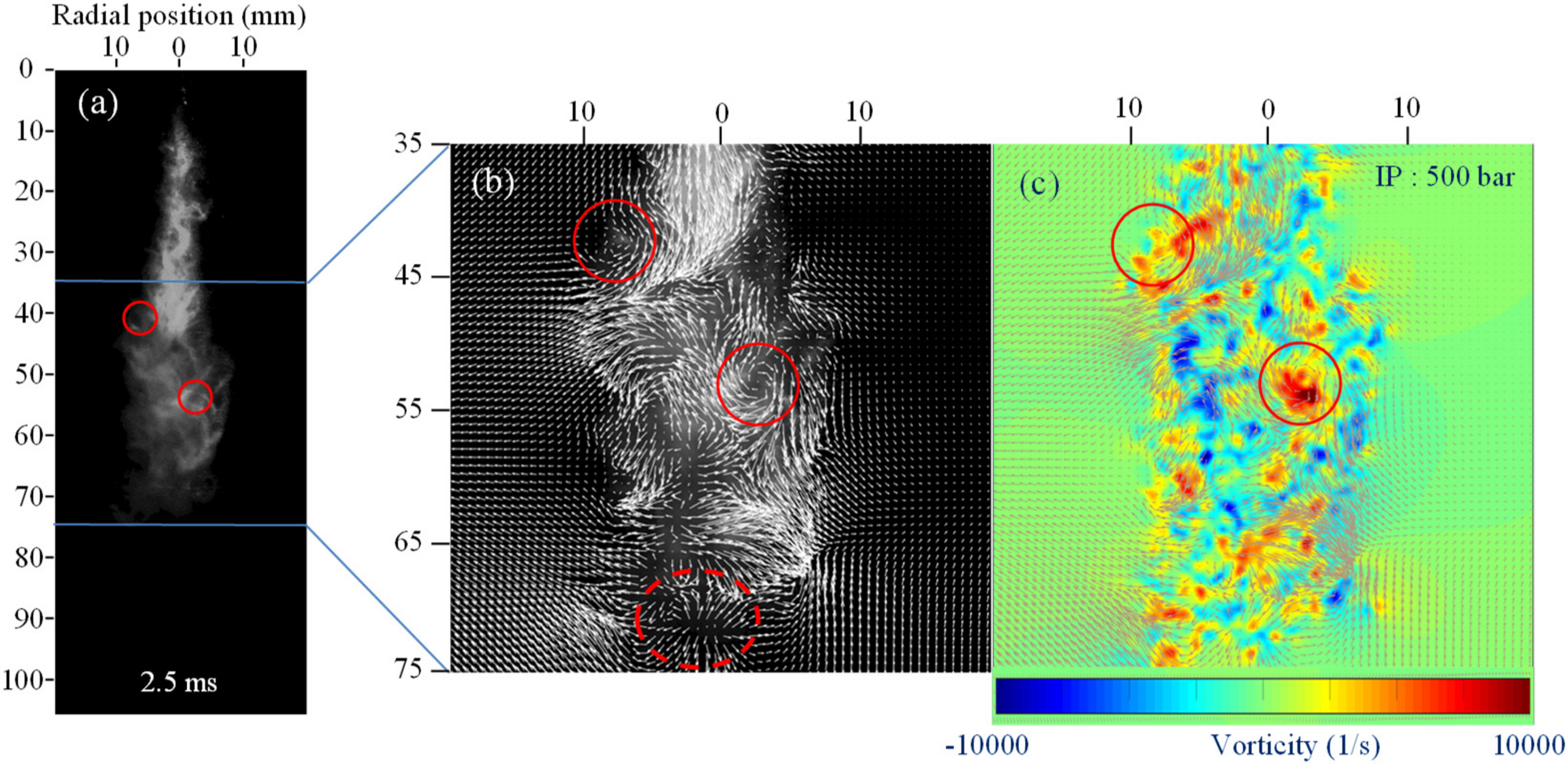
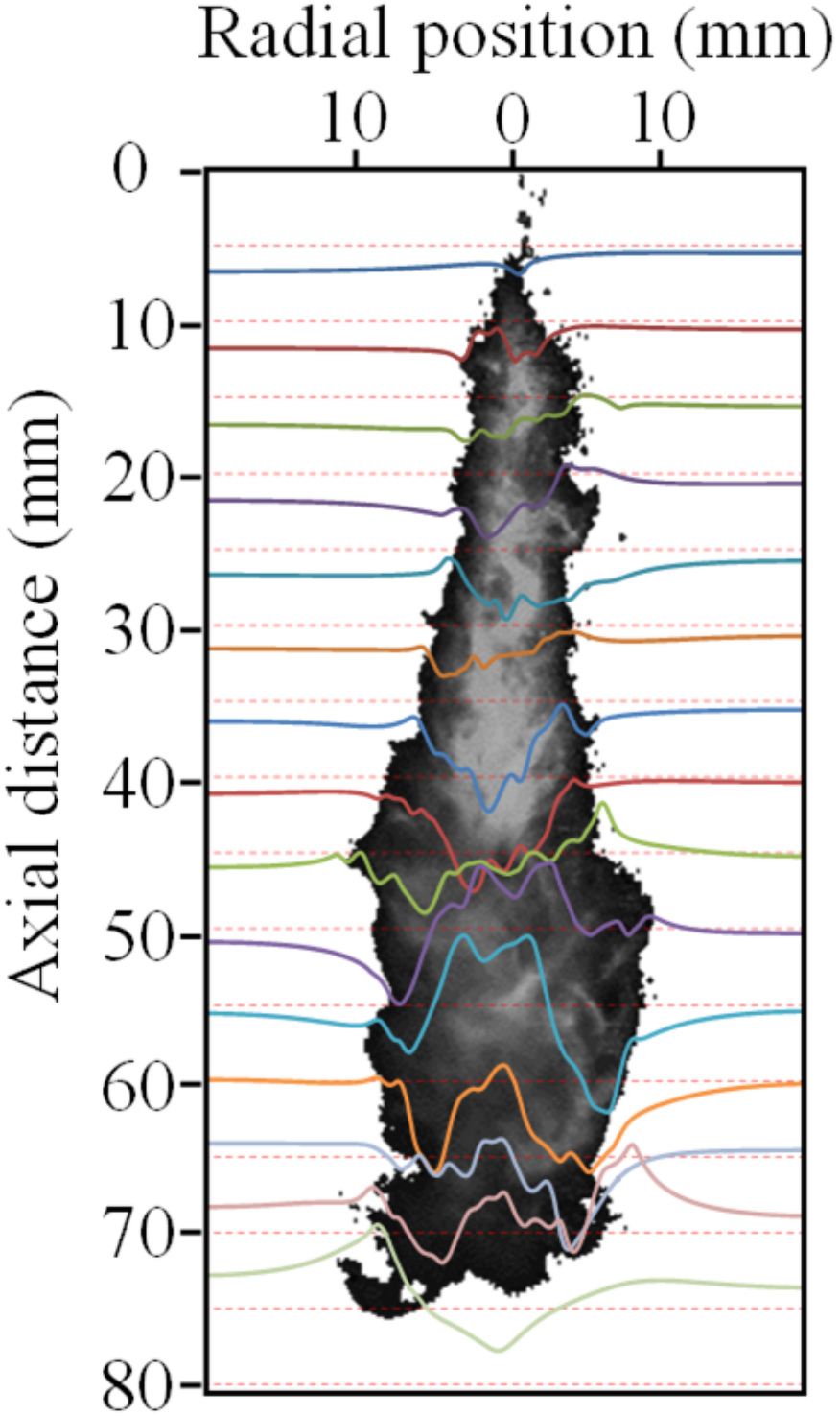
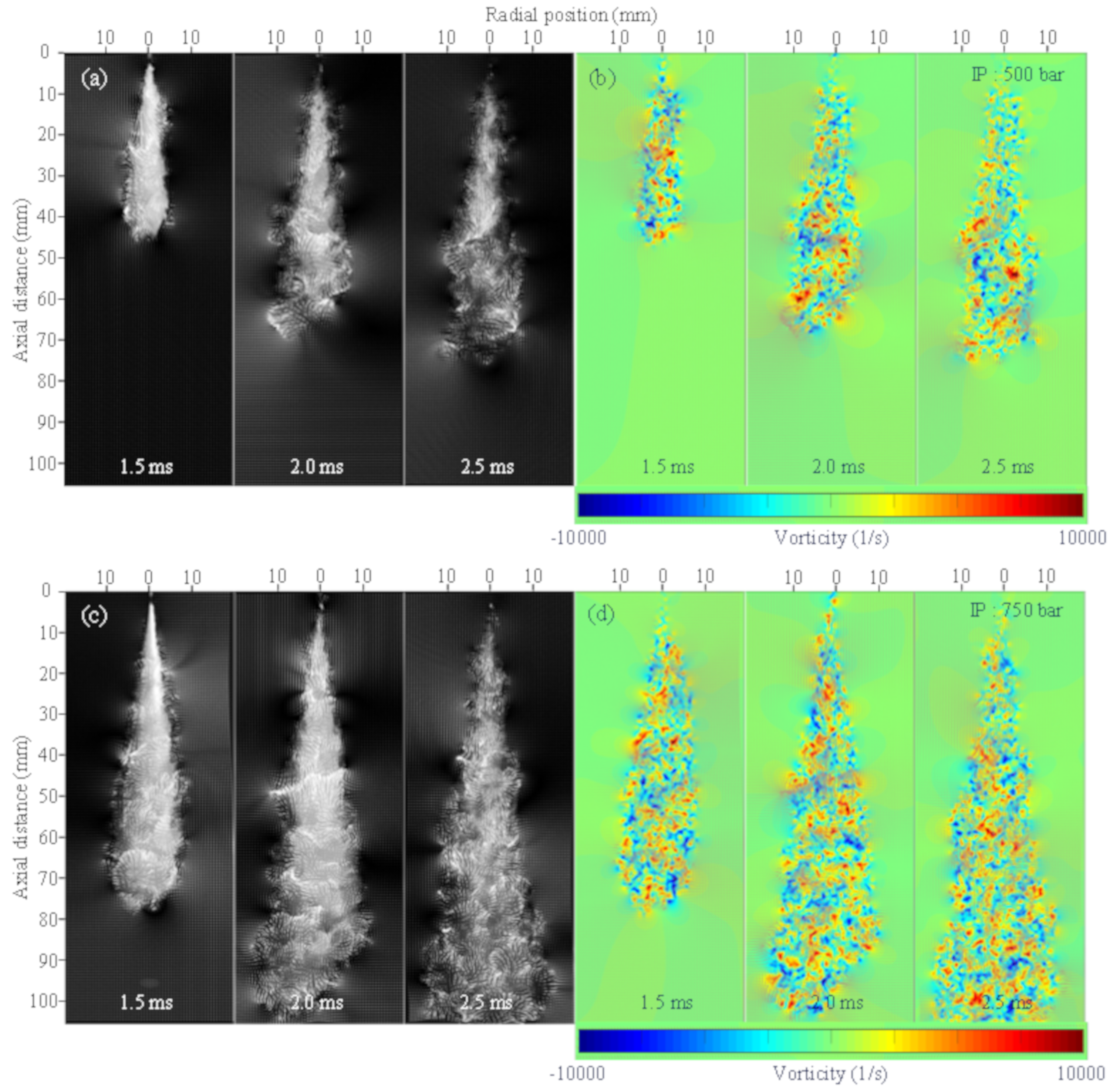

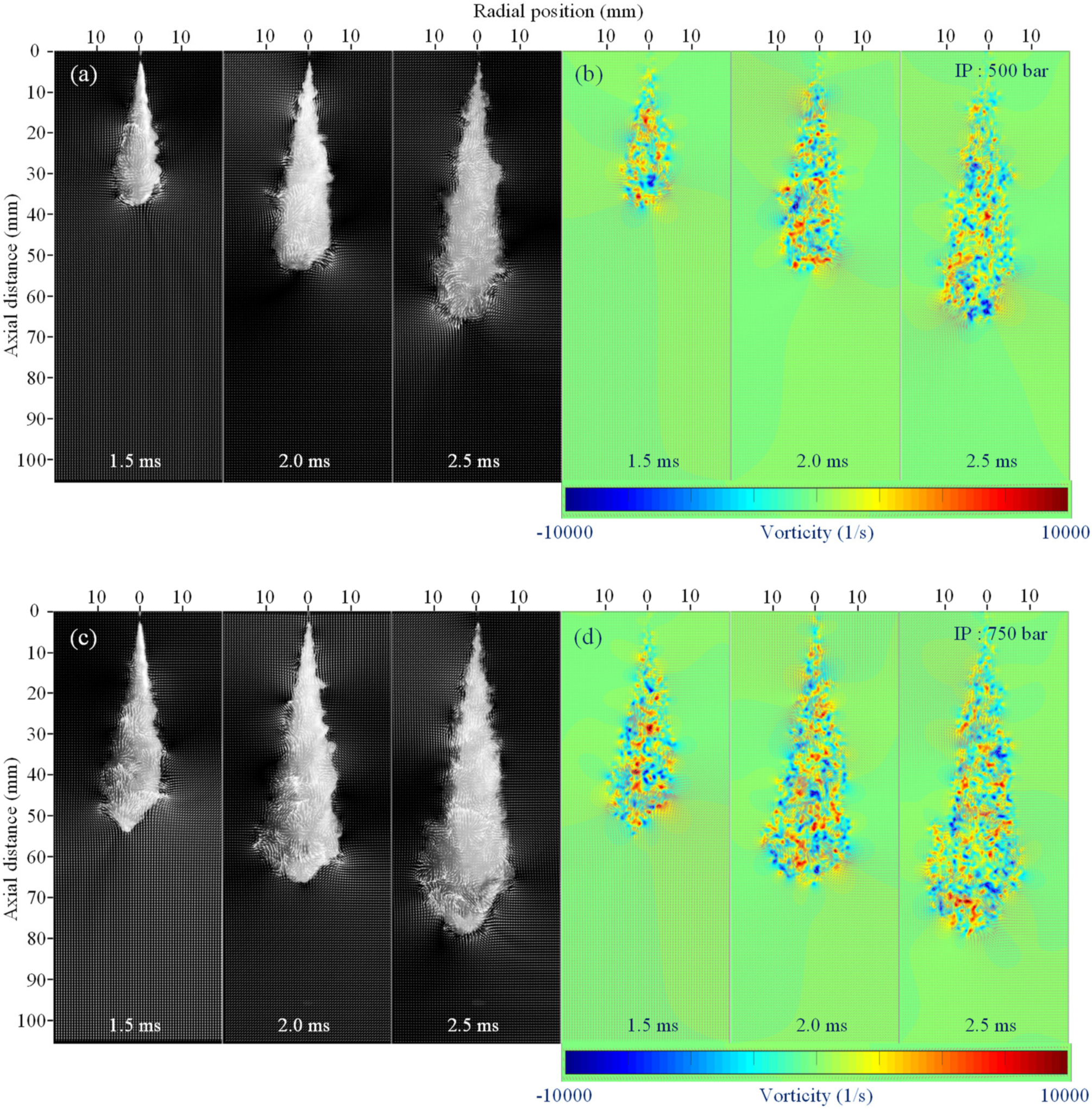
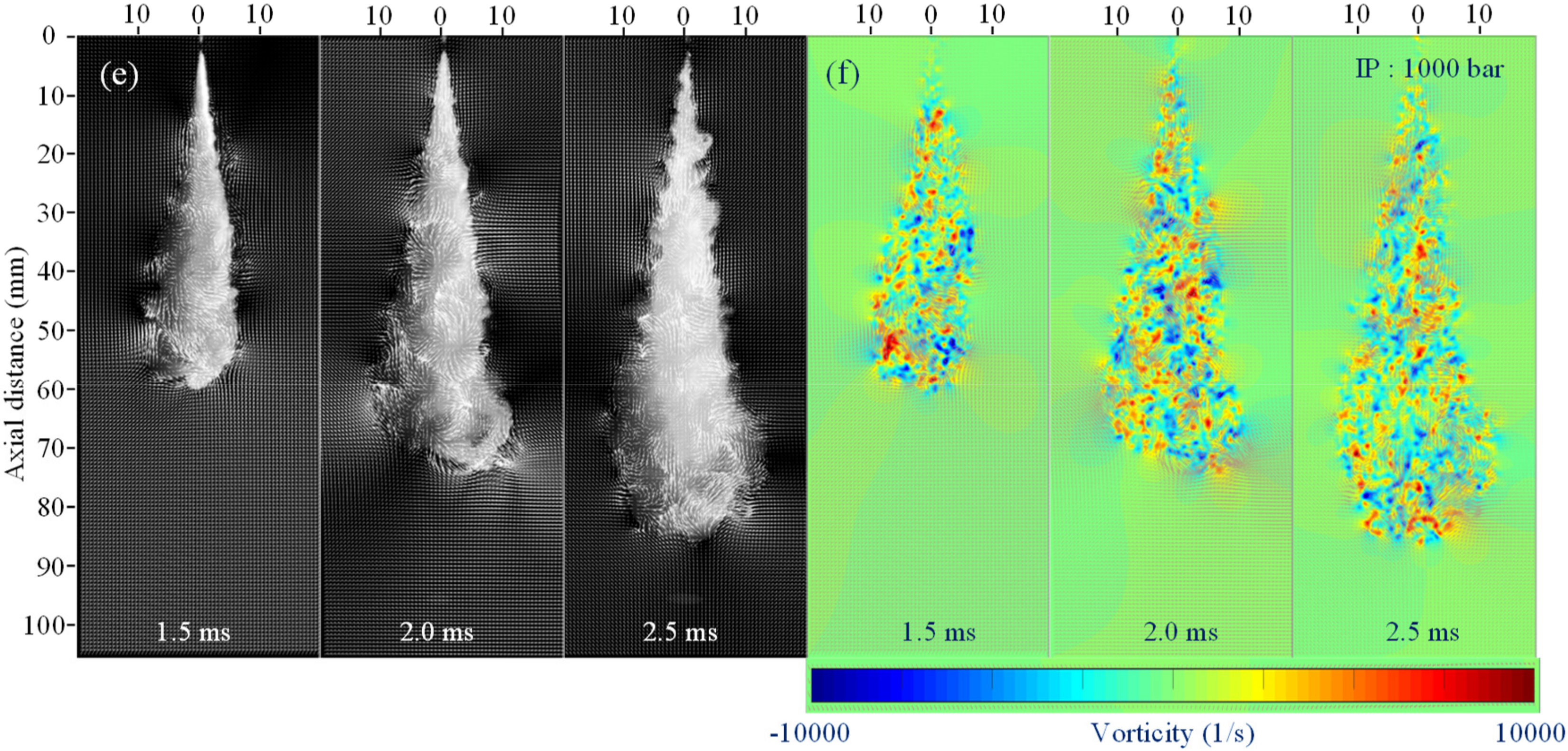
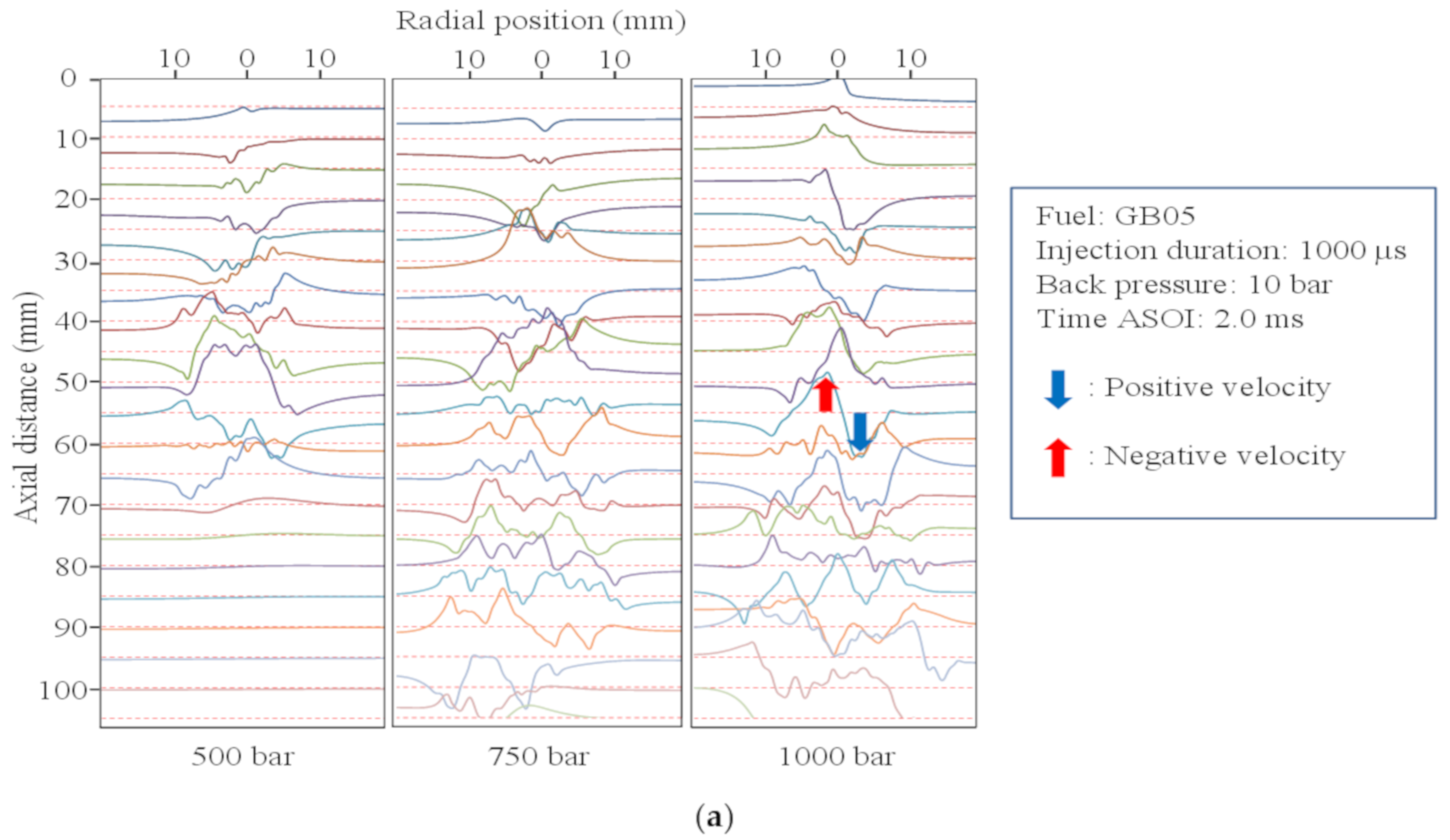

| Test Item | Unit | Test Method | GB00 | GB05 | B100 | * D100 |
|---|---|---|---|---|---|---|
| Kinematic Viscosity (40 °C) | mm2/s | KS M ISO 3104:2008 | 0.735 [30,31] | - | 4.229 | 2.798 |
| Lubricity | µm | KS R ISO 12156-1:2012 | 548 | 290 | 189 | 238 |
| Cloud Point | °C | KS M ISO 3015:2008 | −57 | −37 | 3 | −5 |
| Pour Point | °C | ASTM D6749:2002 | −57 | −57 | 1 | −9 |
| Density (15 °C) | kg/m3 | KS M ISO 12185:2003 | 712.7 | 722.3 | 882.3 | 826.3 |
| Surface Tension | mN/m | 22.6 [32] | ** 22.9 | ** 27.1 |
| Description | Schlieren | PLIF-PIV |
|---|---|---|
| Test fuel | GB05 and D100 | GB05 |
| Particle tracer seed (KF-96) | - | 1% |
| Injector type | Single hole injector, Dia. 300 µm | |
| Fuel injection system | Diesel common-rail system | |
| Simulated speed | 2000 rpm | |
| Injection duration | 1000 µs | |
| Injection pressure | 500, 750 and 100 bar | |
| Ambient pressure (N2) in CVCC | 10 and 50 bar | |
© 2020 by the authors. Licensee MDPI, Basel, Switzerland. This article is an open access article distributed under the terms and conditions of the Creative Commons Attribution (CC BY) license (http://creativecommons.org/licenses/by/4.0/).
Share and Cite
Thongchai, S.; Lim, O. Macroscopic Spray Behavior of a Single-Hole Common Rail Diesel Injector Using Gasoline-Blended 5% Biodiesel. Energies 2020, 13, 2276. https://doi.org/10.3390/en13092276
Thongchai S, Lim O. Macroscopic Spray Behavior of a Single-Hole Common Rail Diesel Injector Using Gasoline-Blended 5% Biodiesel. Energies. 2020; 13(9):2276. https://doi.org/10.3390/en13092276
Chicago/Turabian StyleThongchai, Sakda, and Ocktaeck Lim. 2020. "Macroscopic Spray Behavior of a Single-Hole Common Rail Diesel Injector Using Gasoline-Blended 5% Biodiesel" Energies 13, no. 9: 2276. https://doi.org/10.3390/en13092276
APA StyleThongchai, S., & Lim, O. (2020). Macroscopic Spray Behavior of a Single-Hole Common Rail Diesel Injector Using Gasoline-Blended 5% Biodiesel. Energies, 13(9), 2276. https://doi.org/10.3390/en13092276




